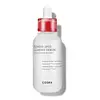What's inside
What's inside
 Key Ingredients
Key Ingredients

 Benefits
Benefits

 Concerns
Concerns

 Ingredients Side-by-side
Ingredients Side-by-side

Propolis Extract
Skin ConditioningButylene Glycol
HumectantNiacinamide
SmoothingPanthenol
Skin Conditioning1,2-Hexanediol
Skin ConditioningHydroxyethyl Acrylate/Sodium Acryloyldimethyl Taurate Copolymer
Emulsion StabilisingEctoin
Skin ConditioningEthylhexylglycerin
Skin ConditioningGlycerin
HumectantPolyglyceryl-10 Laurate
Skin ConditioningPolyglyceryl-10 Myristate
Skin ConditioningAllantoin
Skin ConditioningSodium Hyaluronate
HumectantAsiaticoside
AntioxidantAsiatic Acid
Skin ConditioningMadecassic Acid
Skin ConditioningHelianthus Annuus Seed Oil
EmollientMacadamia Ternifolia Seed Oil
EmollientMelaleuca Alternifolia Leaf Oil
AntioxidantSucrose Distearate
EmollientGlyceryl Stearate
EmollientHydrogenated Lecithin
EmulsifyingDipropylene Glycol
HumectantCeramide NP
Skin ConditioningPropolis Extract, Butylene Glycol, Niacinamide, Panthenol, 1,2-Hexanediol, Hydroxyethyl Acrylate/Sodium Acryloyldimethyl Taurate Copolymer, Ectoin, Ethylhexylglycerin, Glycerin, Polyglyceryl-10 Laurate, Polyglyceryl-10 Myristate, Allantoin, Sodium Hyaluronate, Asiaticoside, Asiatic Acid, Madecassic Acid, Helianthus Annuus Seed Oil, Macadamia Ternifolia Seed Oil, Melaleuca Alternifolia Leaf Oil, Sucrose Distearate, Glyceryl Stearate, Hydrogenated Lecithin, Dipropylene Glycol, Ceramide NP
Water
Skin ConditioningAlcohol Denat.
AntimicrobialGlycerin
HumectantPropanediol
SolventAmmonium Acryloyldimethyltaurate/Vp Copolymer
Coco-Caprylate/Caprate
EmollientEthyl Macadamiate
Skin ConditioningPhenoxyethanol
PreservativeParfum
MaskingSesamum Indicum Seed Oil
Emollient3-O-Ethyl Ascorbic Acid
Skin ConditioningLimonene
PerfumingCitric Acid
BufferingSodium Hyaluronate
HumectantTrisodium Ethylenediamine Disuccinate
Myrciaria Dubia Fruit Extract
Skin ConditioningBenzyl Salicylate
PerfumingLinalool
PerfumingBenzyl Alcohol
PerfumingAloe Barbadensis Leaf Juice Powder
Skin ConditioningSodium Hydroxide
BufferingCitral
PerfumingTocopherol
AntioxidantMalic Acid
BufferingCI 15510
Cosmetic ColorantCI 15985
Cosmetic ColorantWater, Alcohol Denat., Glycerin, Propanediol, Ammonium Acryloyldimethyltaurate/Vp Copolymer, Coco-Caprylate/Caprate, Ethyl Macadamiate, Phenoxyethanol, Parfum, Sesamum Indicum Seed Oil, 3-O-Ethyl Ascorbic Acid, Limonene, Citric Acid, Sodium Hyaluronate, Trisodium Ethylenediamine Disuccinate, Myrciaria Dubia Fruit Extract, Benzyl Salicylate, Linalool, Benzyl Alcohol, Aloe Barbadensis Leaf Juice Powder, Sodium Hydroxide, Citral, Tocopherol, Malic Acid, CI 15510, CI 15985
 Reviews
Reviews

Ingredients Explained
These ingredients are found in both products.
Ingredients higher up in an ingredient list are typically present in a larger amount.
Glycerin is already naturally found in your skin. It helps moisturize and protect your skin.
A study from 2016 found glycerin to be more effective as a humectant than AHAs and hyaluronic acid.
As a humectant, it helps the skin stay hydrated by pulling moisture to your skin. The low molecular weight of glycerin allows it to pull moisture into the deeper layers of your skin.
Hydrated skin improves your skin barrier; Your skin barrier helps protect against irritants and bacteria.
Glycerin has also been found to have antimicrobial and antiviral properties. Due to these properties, glycerin is often used in wound and burn treatments.
In cosmetics, glycerin is usually derived from plants such as soybean or palm. However, it can also be sourced from animals, such as tallow or animal fat.
This ingredient is organic, colorless, odorless, and non-toxic.
Glycerin is the name for this ingredient in American English. British English uses Glycerol/Glycerine.
Learn more about GlycerinSodium Hyaluronate is hyaluronic acid's salt form. It is commonly derived from the sodium salt of hyaluronic acid.
Like hyaluronic acid, it is great at holding water and acts as a humectant. This makes it a great skin hydrating ingredient.
Sodium Hyaluronate is naturally occurring in our bodies and is mostly found in eye fluid and joints.
These are some other common types of Hyaluronic Acid:
Learn more about Sodium Hyaluronate